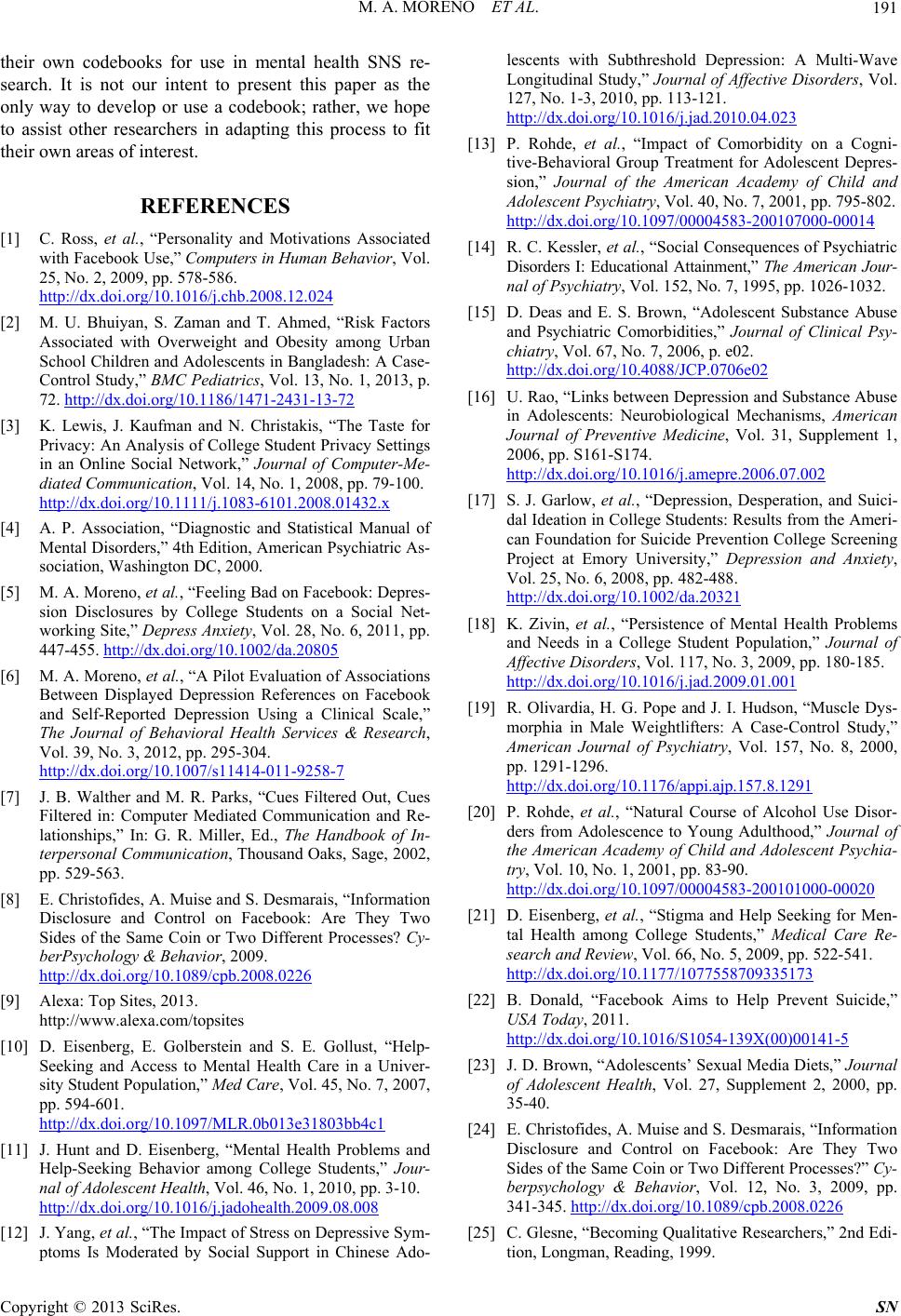
M. A. MORENO ET AL. 191
their own codebooks for use in mental health SNS re-
search. It is not our intent to present this paper as the
only way to develop or use a codebook; rather, we hope
to assist other researchers in adapting this process to fit
their own areas of interest.
REFERENCES
[1] C. Ross, et al., “Personality and Motivations Associated
with Facebook Use,” Computers in Human Behavio r, Vol.
25, No. 2, 2009, pp. 578-586.
http://dx.doi.org/10.1016/j.chb.2008.12.024
[2] M. U. Bhuiyan, S. Zaman and T. Ahmed, “Risk Factors
Associated with Overweight and Obesity among Urban
School Children and Adolescents in Bangladesh: A Case-
Control Study,” BMC Pediatrics, Vol. 13, No. 1, 2013, p.
72. http://dx.doi.org/10.1186/1471-2431-13-72
[3] K. Lewis, J. Kaufman and N. Christakis, “The Taste for
Privacy: An Analysis of College Student Privacy Settings
in an Online Social Network,” Journal of Computer-Me-
diated Communication, Vol. 14, No. 1, 2008, pp. 79-100.
http://dx.doi.org/10.1111/j.1083-6101.2008.01432.x
[4] A. P. Association, “Diagnostic and Statistical Manual of
Mental Disorders,” 4th Edition, American Psychiatric As-
sociation, Washington DC, 2000.
[5] M. A. Moreno, et al., “Feeling Bad on Facebook: Depres-
sion Disclosures by College Students on a Social Net-
working Site,” Depress Anxiety, Vol. 28, No. 6, 2011, pp.
447-455. http://dx.doi.org/10.1002/da.20805
[6] M. A. Moreno, et al., “A Pilot Evaluation of Associations
Between Displayed Depression References on Facebook
and Self-Reported Depression Using a Clinical Scale,”
The Journal of Behavioral Health Services & Research,
Vol. 39, No. 3, 2012, pp. 295-304.
http://dx.doi.org/10.1007/s11414-011-9258-7
[7] J. B. Walther and M. R. Parks, “Cues Filtered Out, Cues
Filtered in: Computer Mediated Communication and Re-
lationships,” In: G. R. Miller, Ed., The Handbook of In-
terpersonal Communication, Thousand Oaks, Sage, 2002,
pp. 529-563.
[8] E. Christofides, A. Muise and S. Desmarais, “Information
Disclosure and Control on Facebook: Are They Two
Sides of the Same Coin or Two Different Processes? Cy-
berPsychology & Behavior, 2009.
http://dx.doi.org/10.1089/cpb.2008.0226
[9] Alexa: Top Sites, 2013.
http://www.alexa.com/topsites
[10] D. Eisenberg, E. Golberstein and S. E. Gollust, “Help-
Seeking and Access to Mental Health Care in a Univer-
sity Stu de nt Popu la t io n, ” Med Care, Vol. 45, No. 7, 2007,
pp. 594-601.
http://dx.doi.org/10.1097/MLR.0b013e31803bb4c1
[11] J. Hunt and D. Eisenberg, “Mental Health Problems and
Help-Seeking Behavior among College Students,” Jour-
nal of Adolescent Health, Vol. 46, No. 1, 2010, pp. 3-10.
http://dx.doi.org/10.1016/j.jadohealth.2009.08.008
[12] J. Yang, et al., “The Impact of Stress on Depressive Sym-
ptoms Is Moderated by Social Support in Chinese Ado-
lescents with Subthreshold Depression: A Multi-Wave
Longitudinal Study,” Journal of Affective Disorders, Vol.
127, No. 1-3, 2010, pp. 113-121.
http://dx.doi.org/10.1016/j.jad.2010.04.023
[13] P. Rohde, et al., “Impact of Comorbidity on a Cogni-
tive-Behavioral Group Treatment for Adolescent Depres-
sion,” Journal of the American Academy of Child and
Adolescent Psychiatry, Vol. 40, No. 7, 2001, pp. 795-802.
http://dx.doi.org/10.1097/00004583-200107000-00014
[14] R. C. Kessler, et al. , “Social Consequences of Psychiatric
Disorders I: Educational Attainment,” The American Jour-
nal of Psychiatry, Vol. 152, No. 7, 1995, pp. 1026-1032.
[15] D. Deas and E. S. Brown, “Adolescent Substance Abuse
and Psychiatric Comorbidities,” Journal of Clinical Psy-
chiatry, Vol. 67, No. 7, 2006, p. e02.
http://dx.doi.org/10.4088/JCP.0706e02
[16] U. Rao, “Links between Depression and Substance Abuse
in Adolescents: Neurobiological Mechanisms, American
Journal of Preventive Medicine, Vol. 31, Supplement 1,
2006, pp. S161-S174.
http://dx.doi.org/10.1016/j.amepre.2006.07.002
[17] S. J. Garlow, et al., “Depression, Desperation, and Suici-
dal Ideation in College Students: Results from the Ameri-
can Foundation for Suicide Prevention College Screening
Project at Emory University,” Depression and Anxiety,
Vol. 25, No. 6, 2008, pp. 482-488.
http://dx.doi.org/10.1002/da.20321
[18] K. Zivin, et al., “Persistence of Mental Health Problems
and Needs in a College Student Population,” Journal of
Affective Disorders, Vol. 117, No. 3, 2009, pp. 180-185.
http://dx.doi.org/10.1016/j.jad.2009.01.001
[19] R. Olivardia, H. G. Pope and J. I. Hudson, “Muscle Dys-
morphia in Male Weightlifters: A Case-Control Study,”
American Journal of Psychiatry, Vol. 157, No. 8, 2000,
pp. 1291-1296.
http://dx.doi.org/10.1176/appi.ajp.157.8.1291
[20] P. Rohde, et al., “Natural Course of Alcohol Use Disor-
ders from Adolescence to Young Adulthood,” Journal of
the American Academy of Child and Adolescent Psychia-
try, Vol. 10, No. 1, 2001, pp. 83-90.
http://dx.doi.org/10.1097/00004583-200101000-00020
[21] D. Eisenberg, et al., “Stigma and Help Seeking for Men-
tal Health among College Students,” Medical Care Re-
search and Review, Vol. 66, No. 5, 2009, pp. 522-541.
http://dx.doi.org/10.1177/1077558709335173
[22] B. Donald, “Facebook Aims to Help Prevent Suicide,”
USA Today, 2011.
http://dx.doi.org/10.1016/S1054-139X(00)00141-5
[23] J. D. Brown, “Adolescents’ Sexual Media Diets,” Journal
of Adolescent Health, Vol. 27, Supplement 2, 2000, pp.
35-40.
[24] E. Christofides, A. Muise and S. Desmarais, “Information
Disclosure and Control on Facebook: Are They Two
Sides of the Same Coin or Two Different Processes?” Cy-
berpsychology & Behavior, Vol. 12, No. 3, 2009, pp.
341-345. http://dx.doi.org/10.1089/cpb.2008.0226
[25] C. Glesne, “Becoming Qualitative Researchers,” 2nd Edi-
tion, Longman, Reading, 1999.
Copyright © 2013 SciRes. SN